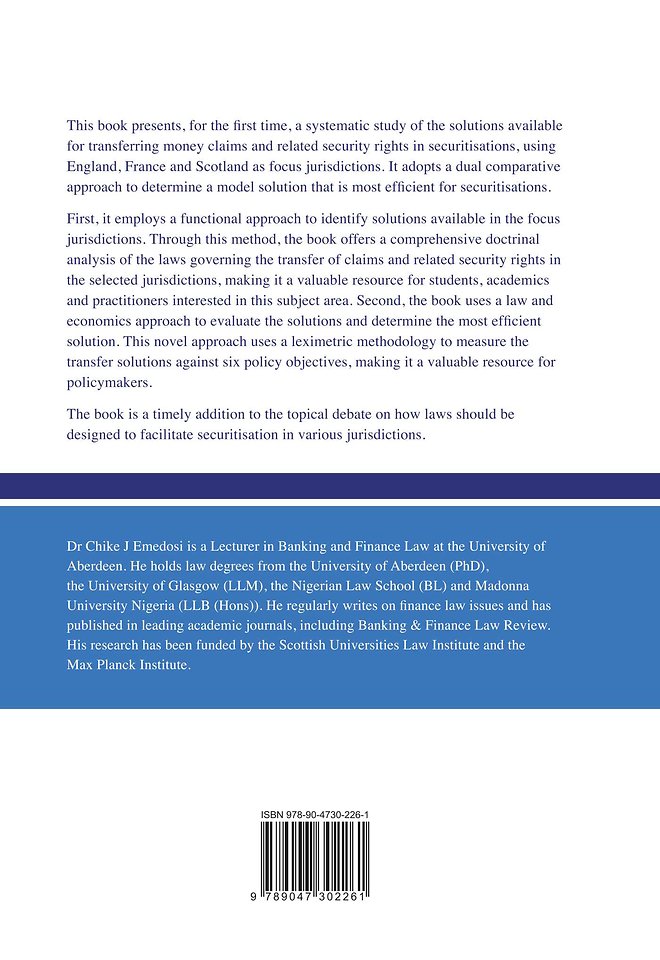The Transfer of Rights in Securitisations
A Law and Economics Analysis
Samenvatting
This book presents, for the first time, a systematic study of the solutions available for transferring money claims and related security rights in securitisations, using England, France and Scotland as focus jurisdictions. It adopts a dual comparative approach to determine a model solution that is most efficient for securitisations.
First, it employs a functional approach to identify solutions available in the focus jurisdictions. Through this method, the book offers a comprehensive doctrinal analysis of the laws governing the transfer of claims and related security rights in the selected jurisdictions, making it a valuable resource for students, academics and practitioners interested in this subject area. Second, the book uses a law and economics approach to evaluate the solutions and determine the most efficient solution. This novel approach uses a leximetric methodology to measure the transfer solutions against six policy objectives, making it a valuable resource for policymakers.
The book is a timely addition to the topical debate on how laws should be designed to facilitate securitisation in various jurisdictions.
Trefwoorden
Specificaties
Inhoudsopgave
Acknowledgements xi
Part I
1 INTRODUCTION 3
1.1 Background 3
1.2 Structure 6
2 SECURITISATION AND THE 2007/08 GLOBAL FINANCIAL CRISIS 9
2.1 Nature and process of securitisation 9
2.1.1 Definition of securitisation 9
2.1.2 Process of securitisation 10
2.2 Origin of securitisation 13
2.3 The global financial crisis 16
2.3.1 The subprime mortgage crisis 16
2.3.2 The interbank credit crisis 18
2.3.3 The solvency crisis 18
2.4 The role of securitisation in the global financial crisis 19
2.4.1 Creation of complex financial products 20
2.4.2 Amplification of losses 25
2.4.3 Opacity 26
2.4.4 The originate-to-distribute narrative 27
2.5 Conclusion 28
3 SECURITISATION: ECONOMIC FUNCTION AND VALUE 31
3.1 Financial value of securitisation 32
3.1.1 Securitisation as a funding tool 33
3.1.2 Securitisation as a risk management tool 38
3.1.3 Securitisation as an investment tool 40
3.2 Securitisation as an instrument for economic growth after the GFC 40
3.2.1 Basel III framework 41
3.2.2 Credit-impact analysis of Basel III and the motivation for the revival of securitisation 44
3.3 Conclusion 47
Part II
4 METHODOLOGY FOR ANALYSIS OF TRANSFER SOLUTIONS 53
4.1 The functional approach 53
4.1.1 An overview of the approach 53
4.1.2 Limitations of the approach 55
4.1.3 Relevance of the approach 57
4.2 The law and economics approach 57
4.2.1 An overview of the approach 57
4.2.2 Basic concepts and models 65
4.2.3 Pareto efficiency and Kaldor-Hicks efficiency: application and research scope 69
4.3 Legal transplant 71
4.3.1 An overview of the concept 71
4.3.2 Relevance and application to this research 72
4.4 Conclusion 73
5 TRANSFER OF RIGHTS UNDER SCOTS LAW 75
5.1 Security rights in Scots law: nature and constitution 76
5.1.1 Definition and types of security rights 76
5.1.2 Types and constitution of real security rights 77
5.1.3 Concluding comments 89
5.2 Accessory principle and transfer of security rights under Scots law 89
5.2.1 Initial comments 89
5.2.2 Accessoriness of real security 90
5.2.3 Concluding comments 97
5.3 Solutions available for transferring security rights in securitisations under Scots law 98
5.3.1 Initial comments 98
5.3.2 Assignation 98
5.3.3 Trust 110
5.4 Conclusion 114
6 TRANSFER OF RIGHTS UNDER ENGLISH LAW 115
6.1 Accessory principle and transfer of security rights under English law 115
6.1.1 Overview of the English law of security rights 115
6.1.2 The accessory principle 117
6.1.3 Concluding comments 120
6.2 Solutions available for transferring security rights in securitisations under English law 120
6.2.1 Initial comments 120
6.2.2 Novation 121
6.2.3 Assignment 124
6.2.4 Trust 129
6.3 Conclusion 134
7 TRANSFER OF RIGHTS UNDER FRENCH LAW 137
7.1 Introduction to the French securitisation legal framework 137
7.1.1 An overview of the French legal framework prior to the French Securitisation Act of 1988 137
7.1.2 The 1988 Act and its reforms 140
7.1.3 New securitisation entities under French law 141
7.2 Assignment of rights under the FCC 142
7.2.1 Introduction and general overview 142
7.2.2 The accessoriness question under articles 1321ff of the FCC 144
7.2.3 Limitations of assignment of rights under the FCC 150
7.3 Transfer by way of subrogation 151
7.3.1 An overview of French law on subrogation 151
7.3.2 Subrogation: advantages and disadvantages for securitisations 152
7.4 Assignment under the Dailly law 153
7.4.1 General overview of Dailly assignment of receivables 153
7.4.2 Dailly assignments: advantages and disadvantages for securitisations 154
7.5 Assignment under French securitisation law (i.e. FCT assignment or French bordereau) 156
7.5.1 General overview of FCT assignments 156
7.5.2 FCT assignments: advantages and disadvantages for securitisations 157
7.6 Conclusion 157
8 LAW AND ECONOMICS ANALYSIS 159
8.1 The publicity principle 159
8.1.1 Nature 159
8.1.2 Scots law 160
8.1.3 English law and French law 163
8.1.4 Concluding comments 166
8.2 Comparative analysis 167
8.2.1 Initial comments 167
8.2.2 Policy one: debtors should be protected 169
8.2.3 Policy two: third-party protection 175
8.2.4 Policy three: facilitation of future receivables transfers 178
8.2.5 Policy four: facilitation of non-publicity transfer 188
8.2.6 Policy five: validity of transfer 191
8.2.7 Policy six: the accessorium principle 195
8.2.8 Efficiency analysis 198
8.3 A case for a model solution 200
8.3.1 Initial comments 200
8.3.2 The accessorium principle revisited 200
8.3.3 Effect of the assignor’s insolvency on assignments of future receivables 202
8.3.4 Registration costs 203
8.3.5 Registration-only approach for securitisations 204
8.3.6 Concluding comments 205
8.4 Transferability of the model solution 206
8.4.1 Initial comments 206
8.4.2 The divergence 209
8.4.3 Applicability in English law 210
8.4.4 Applicability in French law 212
9 CONCLUSION 215
BIBLIOGRAPHY 217
Anderen die dit boek kochten, kochten ook
Rubrieken
- cadeauboeken
- computer en informatica
- economie
- filosofie
- flora en fauna
- geneeskunde
- geschiedenis
- gezondheid
- jeugd
- juridisch
- koken en eten
- kunst en cultuur
- literatuur en romans
- mens en maatschappij
- naslagwerken
- non-fictie informatief/professioneel
- paramedisch
- psychologie
- reizen
- religie
- schoolboeken
- spiritualiteit
- sport, hobby, lifestyle
- thrillers en spanning
- wetenschap en techniek
- woordenboeken en taal









